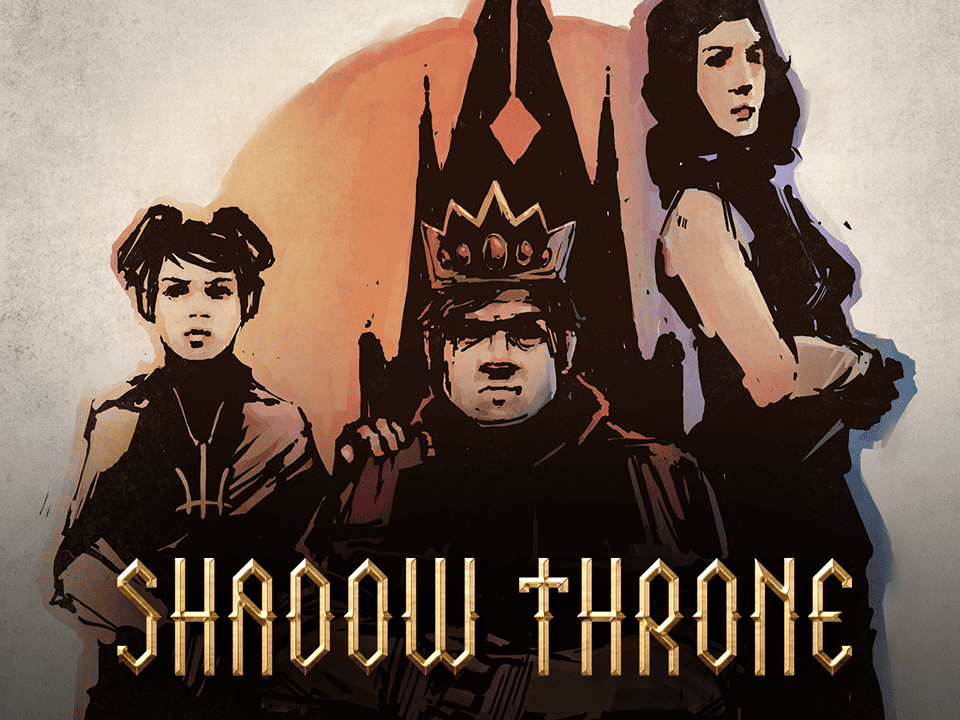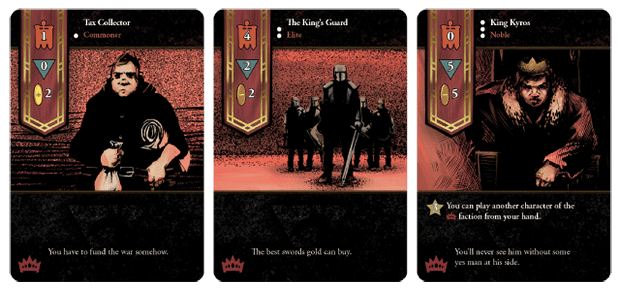
Teale Fristoe is the founder and head designer of Nothing Sacred Games. His games include Corporate America and Shadow Throne, which is currently on Kickstarter.
Today I want to talk about how Shadow Throne is the product of a personal goal of mine: exploring the limits of the drafting mechanic. Before we start today, I encourage you to:



Shadow Throne is a hidden, multiple pool draft game, meaning each player has a pool that is hidden from the other players that gets passed between players as the game proceeds. It manages to break many drafting conventions while still taking advantage of the mechanic’s strong points in several ways.
DRAFTING HANDS
In most modern drafting games (7 Wonders being the stand out, which set the precedent for many that have followed since), players immediately play the cards they draft. Magic, another popular drafting game, involves drafting an entire deck of cards. Shadow Throne falls between these: players draft a hand of cards, then play some of those cards. By drafting a hand, the game plays quickly, but still gives players the opportunity to develop plans and adapt as the game procedes. Note that Fairy Tale (a game I wasn’t aware of when developing Shadow Throne) also has players draft a hand of cards, but this is the only other hand drafting game I’m aware of.
INDEPENDENT HANDS
In most drafting games, you’ll draft multiple times, always building based on what you drafted previously. In Shadow Throne, each hand is independent–going for yellow one hand has no bearing on whether you’ll go yellow in the next. It’s a bit more like Poker in this regard. As far as I know, no other heavy drafting game has this feature, and it improves the experience a bit because it makes switching drafting directions unnecessary (something that’s easy to forget, even for experienced players).
HIGHLY INTERACTIVE SUBSYSTEM
Drafting games can be divided into two parts: the drafting part, and the other part. In most drafting games, that other part is not particularly interactive. You’re usually just building up some sort of tableau. In Shadow Throne, the other part is highly interactive. Each player’s cards can affect the other players’ cards (for example, killing them or changing their color). Players also communally determine the winning color each round.
STILL SIMULTANEOUS
One of the biggest advantage of hidden, multiple pool drafting games is that players can draft simultaneously. However, if the other part is complex (see Magic above), you’ll lose that advantage. With Shadow Throne, all choices are made through cards (a player never gets to point at a card or player to make a choice), so all action is simultaneous the whole way through. There is never the need for turn order, because there are no turns. Designing exciting, balanced cards that could be played simultaneously was sometimes tricky, but it was a fun design challenge.

SHIFTING VALUES.
One of the biggest challenges of designing a drafting game is keeping the different options on relatively equal power levels, but still making them different. Shadow Throne keeps all cards different but useful in two ways:
DANGERS OF DRAFTING
While I think Shadow Throne does a great job of taking drafting in a new direction, it also helped me realize a few difficult challenges all heavy drafting games will encounter.
DRAFTING ERRORS
In probably half the games of Shadow Throne I’ve played, even with experienced drafters, the game screeches to a halt at some point as everyone has to count their cards and figure out why someone is missing a card or has an extra. Usually, this is the result of someone stacking two pools on top of each other, though there are many other possible errors. As far as I can tell, the only way to avoid this sort of issue is if players are really strict (in other words, not fun), or use player mats (in other words, more components and a higher cost to produce the game).
NO BREAKS
In general, I think simultaneous play is something you should shoot for. It means that instead of waiting for every player every turn, you’re only waiting for the slowest player. But with no obvious time to get up from the table, bathroom or smartphone breaks can be pretty disruptive and awkward. And if one player is taking a particularly long time making a decision, he or she is going to be the target of groans from the whole group.
SUBTLETY AND CONFUSION
It turns out there’s actually one pretty good reason to stick with the status quo: people can pick it up much more easily. Explaining Shadow Throne to new people can be challenging, and it usually takes a couple of hands before people really start getting the game. This will always be a challenge for games that innovate, but that’s a sacrifice I’m happy to make.
So, that’s how Shadow Throne is building on drafting. It’s only the first of a handful of games I’m working on that take drafting in new directions, and I can’t wait to share some more. I’ve personally found this approach to game design very rewarding and refreshing, but I’d love to hear your thoughts, about drafting specifically or innovative design, in the comments!







